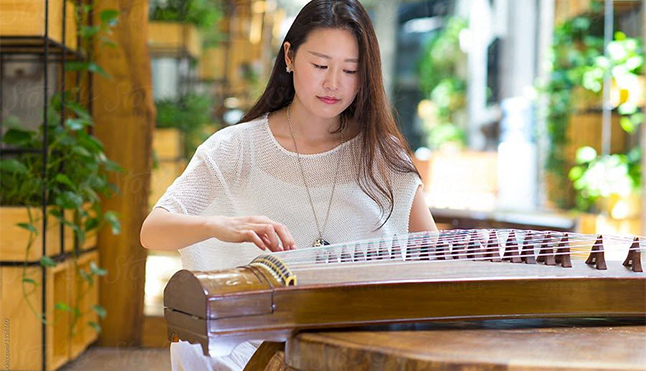
The guzheng, (in Chinese, 古筝) is a traditional Chinese stringed musical instrument. It is one of the main musical instruments of the Han ethnic group and has been widely welcomed by the Chinese people until today. The guzheng is the ancestor of several musical instruments, the Japanese koto, the Korean gayageum.
The guzheng has been around since the period of the Warring Kingdoms, a history of more than 2,500 years. According to legend, the guzheng was originally a weapon and was used to strike. After adding a few strings to it, people found that the guzheng can produce pleasant sounds and gradually became fully a musical instrument.
Guzheng is very popular with new generations. There are two basic schools or styles of performance known as the North and the South, with multiple variations and regional styles.
The modern guzheng is a finger-tapping instrument and is 1.63 meters long with movable bridges and 21 strings. Previously, the guzheng had 25 strings, and the 13-string version was used more in the Tang and Song dynasties. Guzheng strings were made from horsetail hair, and currently most musicians use metal strings or nylon strands.
The timbre of the instrument depends on the material of the strings and the wood. The guzheng built from wutong wood (Paulownia tomentosa), especially the wutong from Lankao, Henan province, has a large resonant cavity.
There are two basic schools or styles of performance known as the North and the South, with multiple variations and regional styles. The northern styles are mainly linked to the Henan and Shandong areas, while the southern styles do so to the Chaozhou and Hakka regions in eastern Guangdong.
The compositions GaoShanLiu Shui (High Mountain Waters) and Han Gong QiuYue (Autumn Moon in Han Palace) belong to the Shandong school. Han ya xi shui (Winter crows playing in the water) and Chu shui lian (Lotus buds sticking out of the water) are important compositions from the Chaozhou and Hakka repertoires respectively.
The GaoShanLiu Shui composition (in Chinese, 高山流水) is one of the ten most famous melodies in ancient China. The name of the piece means "the high mountains and the flowing water".
Wang Shuai graduated from the National Conservatory of Fine Arts of the Chinese Academy of Music.
The legend behind this composition says that the guqin master (in Chinese, 古琴, a seven-stringed Chinese instrument without bridges from the same guzheng family), Bo Ya, was playing the instrument on an arid mountain, and the lumberjack ZhongZiqi He listened to him and understood that his music was described as "the high mountains and the flowing water".
Bo Ya was surprised and said, "My heart resounds in yours." The two became very good friends. When Ziqi died, Bo Ya was devastated to lose a friend who could really read what was on his mind by listening to his music, he broke the guqin instrument and never played in life again. The Chinese word Zhi Yin (confidant), which literally means "to know the voice," also originated from this story.
latercera.com
